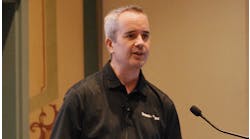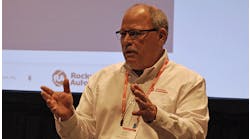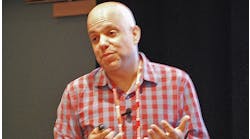“Most of the Industry 4.0 technologies are a way to look at a physical device in a digital environment.” Plex Systems’ Jerry Foster pointed out results achieved through digitalization.
We’ve all spent the past two years in the metaverse. We had no choice. But it’s been eye-opening to see what can be done, from attending online meetings, webinars and conferences to collaborating digitally with colleagues in faraway locations and even commissioning machinery remotely. The possibilities are virtually endless.
We’ve discovered just how much we can get done, and we continue to test the limits of what can be achieved with connectivity to digital environments and data.
It’s no small wonder the virtual manufacturing world is becoming not just a playground, but a viable business endeavor for the gaming industry, explained Jerry Foster, CTO and founder of Plex Systems, who spearheaded the opening session at ROKLive’s second day this week in Orlando, Fla.
Foster cited the many advantages of an industrial metaverse and then welcomed other guests onstage to share quantifiable results of digital implementations.
“With Emulate3D, you can design the machine, configure the floor and train employees before building the physical line,” said Foster. An industrial metaverse allows the user to not only preview production, but to rewind and replay what happened in the factory yesterday and slow it down and observe it. “What if I rewind yesterday’s operation and change something, like a temperature, to find out the downstream effect of that?” he asked.
Rockwell Automation’s Emulate3D is built on the Unity game engine, which is coincidentally used to build video games. Foster said he recently visited an exhibit booth by Epic Games, maker of the Unreal Engine, a 3D gaming engine, at Automation Alley’s Integr8 conference in Detroit.
What was Epic Games, which makes the popular game, Fortnite, doing at a manufacturing conference? “Epic has its sights set to build virtual worlds, even in manufacturing,” explained Foster. “They’ve set up a lab in Detroit to work with automotive manufacturers.”
Things just got real.
Game-changing technology
Plex originated in a forging plant in Michigan more than 20 years ago. “Just-in-time and lean manufacturing were coming in,” explained Foster. “Manufacturers were forcing unprecedented cost-cutting measures on their suppliers. That forging plant survived because we had leadership that was not concerned with the status quo. They went out in the plant and applied new ways of doing business. Plex was built to solve these problems. Plex made manufacturing data available all the way from the shop floor to the top floor.”
Fast forward to the 2020s, and many major obstacles, including supply-chain issues, the labor shortage, cybersecurity and decreasing profit margins, are in manufacturing’s path.
“How do you survive?” asked Foster. “Strong leadership and new technology. But as we implement new technologies, we’re often not looking at an overarching strategy of how they fit together. We’re creating siloes,” he warned.
“Data and feedback loops are critical. When you extend that data thread outside your walls to the customer and back, that is a game-changer. You can even sell your product as a service,” said Foster, who cited his own subscription to Hewlett-Packard (HP) for his home printer.
“I no longer have to pay for ink on my color printer at home,” he explained. “My printer tells them how much I use, and HP sends me ink. I don’t have to find an open store in the middle of the night. I’m seeing other things, from home washing machines to jet engines, being paid for on a usage basis.” All it takes is connecting feedback loops and building digital threads, said Foster.
“Industry 4.0 is connected manufacturing,” explained Foster. “The digital thread is the act of creating a sequence of digital twins. Most of the Industry 4.0 technologies are a way to look at a physical device in a digital environment.”
Real-world results
Emulate3D’s Tyler Phillips, global business development manager, and Andrew Deeble, catalog engineering lead, shared new product features, as well as results from ECM, an Italian customer in the structural-metals industry, which was able to shave five months off of a 10-month project using Emulate3D.
“We’ve been busy connecting with our digital partner ecosystem to increase functionality. We can now connect to Ansys digital-twin models and bring them into a larger simulation testing system,” noted Phillips.
“We can connect to Fanuc Roboguide,” said Deeble. “We start with 3D CAD, and we bring that to life. We’ve added more than 500 new robots and automated storage and retrieval systems to our library. In many cases, it’s low-code or no-code to assemble and configure these system simulations. You can generate the control code automatically. We have rich and deep APIs. ECM had a secret weapon. They took controls testing and worked earlier. All of what we described is available today, plus we’ve been working with ePlan on an upcoming eCAD release.”
Kendrick Plastics, a Plex Systems user, was formed two years ago as a spinoff, manufacturing for Tier 1 and automotive OEMs. “We track everything in our process from torque to screw pressure,” explained David Chupp, IT manager at Kendrick, which consolidated 27 systems into one, decreased scrap rate from 1.8% to 1%, streamlined the PO process from days to minutes and eliminated 40 hours/week of data entry.
“We were able to start gathering insights quickly for every single one of our presses and start driving root-cause validation with the operations team,” said Chupp. “Data by itself has no intrinsic value. Having data is expensive if you don’t use it. We rolled out a program similar to what Uber Eats is. Our users are able to request anything they need to be successful. A single process sends that to our materials team electronically and automatically, and that has driven a lot of our efficiencies.”
Maintenance is a specific area where manufacturers are realizing benefits with digitalization. “Sensors for temperature or vibration are installed in the machines,” explained Luda Domakhina, product strategy for applied artificial intelligence (AI) at Fiix, Rockwell’s cloud-based computerized maintenance management system (CMMS) offering. “Work orders are validated by supervisors. Once work orders are completed, AI is used to help prevent future failures. Digitalization happens in multiple areas in maintenance. Data needs to be entered into the system first.”
Fiix customers report 10-15% maintenance cost savings, 78% reduced time to fill out work orders and a 27% reduction in downtime, said Domakhina.
Another example of real-world results was achieved by a mining operation that realized more than $200 million in cost savings. “When a problem occurs upstream at the mining operation, it can turn into a big problem,” explained Rachael Conrad, vice president, services, Rockwell Automation. “They used decision automation as their pivot and took the variability out. Transformational change really matters.”
Labor assistance
“Everyone in the room is feeling the impact of the great resignation,” said Rockwell’s Conrad. “If we look at the U.S. Bureau of Labor Statistics data, in the United States alone, 47 million people quit their jobs. Over the past 10 years, there’s been a steadily increasing number of people leaving the workforce.”
Conrad identified five reasons for the exodus—retirement, relocation, reconsideration, reshuffling and reluctance to return to physical workplaces.
“People are less likely to relocate,” said Conrad. “Companies have had to adopt work-from-anywhere strategies. People are finding different work-life balances and moving or changing jobs.”
The solution involves retention, recruitment and workforce planning. “Retention is keeping your skilled talent,” explained Conrad. “Develop them and understand how and where they want to work. Recruitment is about branding companies differently. And with workforce planning, how are you going to develop those skills with persona-based strategies? You can’t just hope. Hope is not a good strategy.”
New employees want to learn and be ready to go. Expert capture for video viewing is a new way of working, said Conrad. “You can improve plant-floor and maintenance-team efficiencies with video support. We implemented Vuforia Chalk to provide a virtual expert by your side,” she said.
The editors of Control, Control Design and Smart Industry are reporting live from ROKLive 2022 in Orlando, Florida, to bring you the latest news and insights from the event. When the event comes to a close, the best, most important coverage will be compiled into a report by the editors.
Register now to pre-order the report and be among the first to receive it in your inbox.





